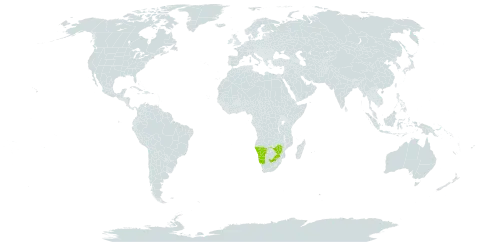Herb up to 0.6 m high. Leaves ovate, acute to acuminate, base cuneate, attenuate, (14-)15-41 (-57) x (5-)6-15(-24) mm; petiole 1-9(-18) mm long. Inflorescence 2-3 inflorescence units umbellately arranged, 1 'umbel' in each axil; inflorescence axis (6-)7-23(-34) mm long; longest peduncle of inflorescence units (1-)4-18(-27) mm long. Bracts: secondary bracts narrowly triangular to narrowly lanceolate, sharply acute, slightly denser on margins and veins; tertiary bracts ovate to elliptic, cuneate at the base, (7.6-)9.3-11.8(-12.4) x (2.1-)2.8-4.2(-4.7) mm, with midrib prominent, and two other veins from the base, initially strigose and with stalked glandular trichomes, but later the glandular trichomes are lost, 'windows' not clearly differentiated, tips often turning purple. Calyx: tube 1.0-1.5 mm long; lobes 3.5-5.0 mm long, inner surface with appressed eglandular trichomes and small glandular trichomes, outer surface dense with small-and large-headed glandular trichomes, margins and veins strigose. Corolla deep purple; tube (5.9-)6.6-9.9(-11.8) mm long, with curved eglandular trichomes and occasional glandular trichomes amongst them; lip in lower position ovate or elliptic, (8-)9-13(-16) x (3.5-)3.6-6.2(-7.0) mm; lip in upper position oblong, (8-)9-14(-16) x (2.0-)2.2-3.2(-3.5) mm. Stamens: filaments with a few curved eglandular trichomes proximally, and a few glandular trichomes distally; thecae superposed, approximated. Disc cupular, with an irregular upper surface or with two awns. Gynoecium: stigma shortly bilobed; style sparsely strigose; ovary ovoid, glabrous to strigose. Capsule initially strigose, then with some eglandular and many stalked glandular trichomes, (6.8-)7.1-8.2 (-8.4) x 2.4-3.3(-4.0) mm. Seeds 1.9-2.-8(-2.9) x 1.6-2.8(-2.9) mm, rough with tall, broadly hooked tubercles.
More
Erect to procumbent perennial herb, up to 0.6 m high. Leaves thinly textured, often with very acute tip. Inflorescence axis longer than 5 mm, so that inflorescence does not appear to be contracted. Tertiary bracts (2.1-) 2.8-4.2(-4.7) mm broad, windows not clearly differentiated. Corolla tube shorter than 14 mm. Capsule (6.8-)7.1-8.2(-8.4) mm long. Flowers deep purple.
